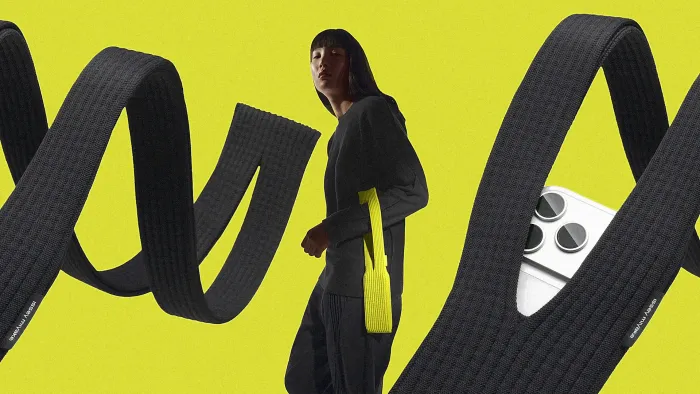
.
Image: Apple
The line had just died down at Hong Kong’s Apple flagship store on Canton Road when I arrived on what happened to be the release day for the iPhone Pocket, the company’s new and very buzzed-about design collaboration between Apple and Issey Miyake Design Studio. I purchased it immediately—a short one in Sapphire blue, as the cross-body version was already sold out.
I observed neither pomp nor circumstance with the overwrought packaging, which I shed on the spot despite its velum-bound elegance and prominent Miyake branding. I was on a working vacation after all, and so I simply looped the Pocket around the strap of my nylon cross-body bag and went about my day in a city whose entire experience is all but governed by smartphone technology. I was going to have to use the thing, not just look at it.
Awkwardness ensued. Bouncing around on my thigh beneath the weight of my phone, the Pocket felt like a surprising, unwanted appendage. An attempt to access the Mass Trasnsit Railway (MTR) system by tapping my phone through the Pocket failed, which meant I had to remove the phone from the pocket altogether. (I accidentally dropped my phone while trying to quickly slip it back into the Pocket amidst the throngs of fellow passengers hustling past me.)
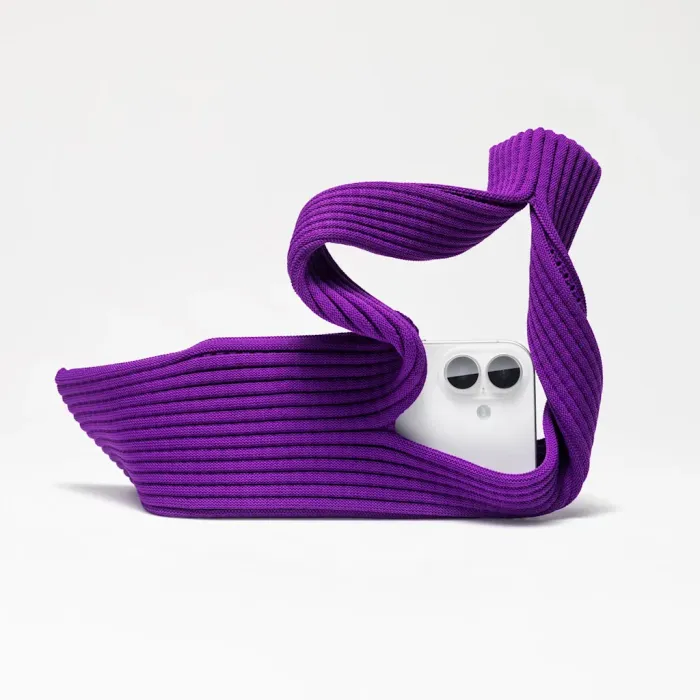
.
Image: Apple
On a quick trip to Shenzhen, China the following day, I experienced a moment of panic before I realized that my Pocket hadn’t been pickpocketed, but rather I had simply intuitively placed my phone in my bag, its familiar location, rather than fiddling with my newest accessory.
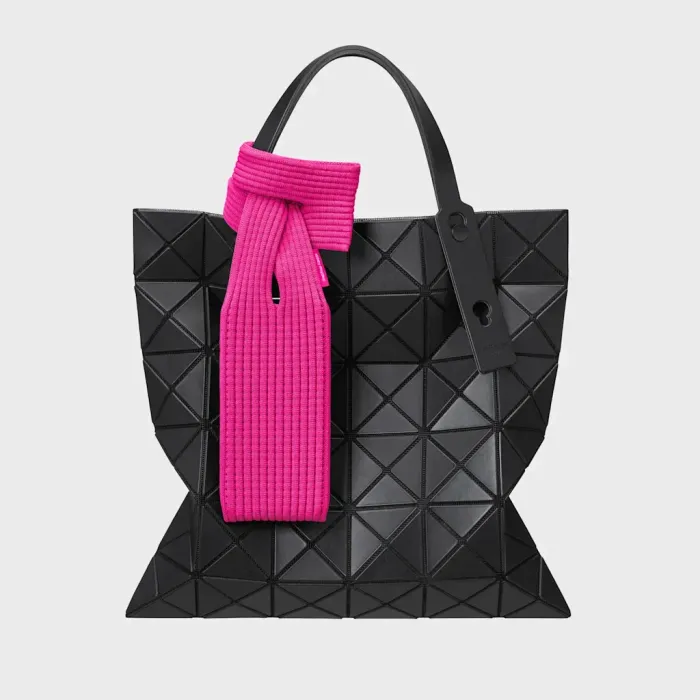
.
Image: Apple
At an eyebrow-raising $229.95 (R3,974) for the crossbody version and $149.95 (R2,591) for the shorter version, the limited-edition iPhone Pocket might be dismissed as an overpriced marketing gimmick, despite Apple’s long history of collaborating with luxury fashion brands. In my case, I am an inveterate fan of the late Issey Miyake’s work, which I collect in various vintages and frequently wear.
I can simply look at the iPhone Pocket and see its potential for abject failure as a functional design object, and yet the Issey lover in me deeply appreciates the way his studio’s clothing and accessories challenge commonly held notions around how a piece of cloth should behave. Miyake’s designs are infamous, in part, for the way they play against the body, allowing the wearer exceptional freedom in how they position the garment.
There is no “right” way to wear Miyake. The iPhone Pocket’s pleats not only allow the accessory to morph in shape according to its contents, but it allows that alteration to remain visible. (Similarly, the shape of the ubiquitous Lucent bag, for example, is designed to distort as the bag is filled with objects.)
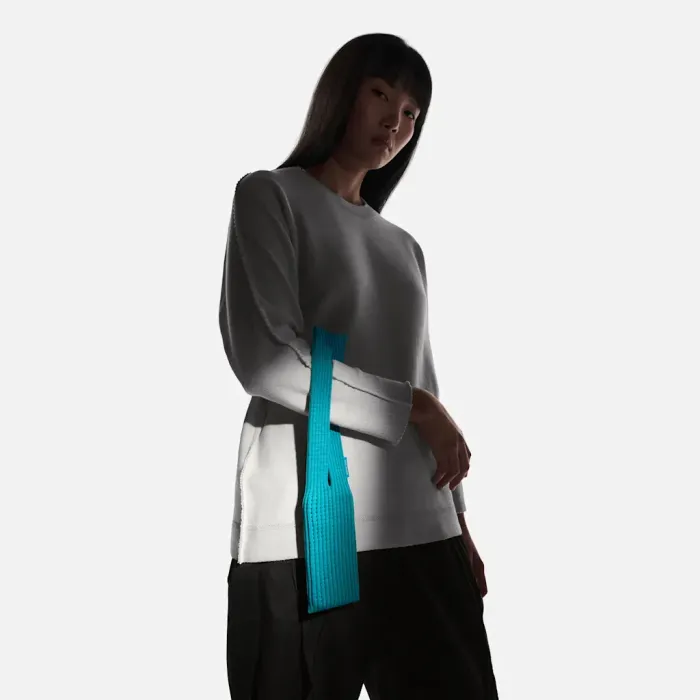
.
Image: Apple
The relationship between Apple founder Steve Jobs and Issey Miyake himself is the stuff of legend: Miyake personally designed the black, mock-neck turtleneck that Jobs infamously paired with his Levi’s 501 jeans and New Balance shoes. Jobs, like many tech executives since, preferred to adopt a uniform as a means of reducing the cognitive load associated with choosing one’s clothing on a daily basis. Indeed, many Miyake megafans, myself included, are drawn to the kind of strangely unique uniformity one may achieve in wearing his clothing. The Pleats Please line, in particular, can be styled endlessly and sits effortlessly against the body in a way that begs for common wear.
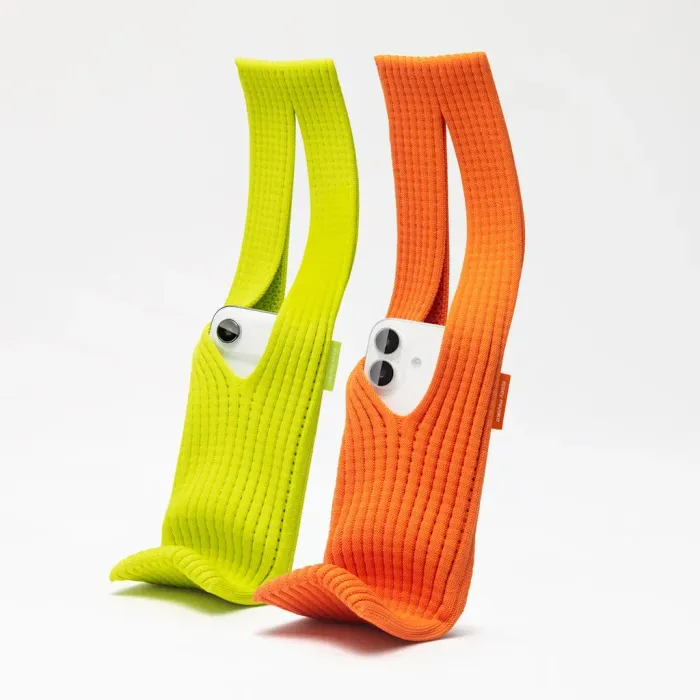
.
Image: Apple
The iPhone Pocket, in contrast, offers friction—and a lot of it. The Miyake Design Studio team knows it, too: Recently quoted in The New York Times, Yoshiyuki Miyamae, the studio’s design director, said that “design should be leaving things a little bit less defined to allow more creativity from the user side.” He also questioned whether the American market was ready for such a development. While it’s true that Americans are less likely to follow the trend of wearing their phones across their bodies, as is commonly seen in Asia, the iPhone Pocket simply looks strange in a way that may bristle against more practical sensibilities.

.
Image: Apple
The sensationalisation of the iPhone Pocket—it has already been panned by the popular press and meme-ified across the internet—poses a stranger version of the initial fervour that surrounded the iPhone itself. (The last time I waited in line to purchase something from Apple was in San Francisco, the day the first iPhone was released!) People don’t quite know what to make of it yet, even though Apple does hold a precedent in its 2004 iPhone Sock, a much cheaper and similarly intentioned, if less intentionally designed object.
As Miyake Design Studio apparently planned, the onus for the design success of the iPhone Pocket seems to be placed squarely on its owner, which is, a risky proposition given the tension it poses, as an object, with the sleek minimalism of Apple’s design philosophy.
In terms of branding, it could be argued that the heavier lift lies with Miyake over Apple, as Miyake holds strong name recognition in Asia, where the iPhone Pocket sold out immediately and where the demand for phone accessories is markedly higher. Its 1994 Pleats Please line has enjoyed a recent surge in popularity in the United States, yet Miyake is a far cry from a household name in America. Apple, on the converse, has a built-in, global audience for everything it produces.
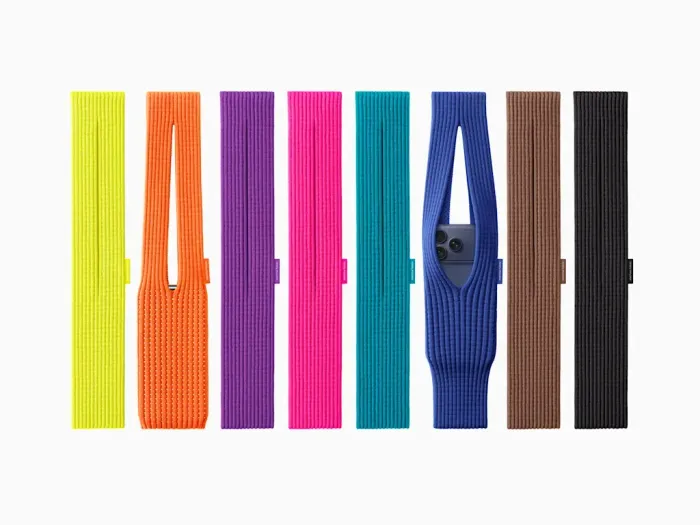
.
Image: Apple
Will the iPhone Pocket catch fire, or will it slip into design obscurity alongside so many other tech accessories gone by? Now freshly arrived back in New York City, I’ve looped my Pocket yet again onto a sturdy leather bowler handbag along with a few other small charms for added flair. I’m willing to give it another try, and am ready for the conversation (and the criticism) that will inevitably follow me.
ABOUT THE AUTHOR
Sarah Hromack is the founder of Soft Labor, a consultancy that works with organizations, designers, and the culture industry. She is the author of the newsletter Soft Labor.
FAST COMPANY
